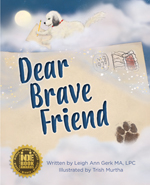See Moira Allen's recent video interview on pet loss!
Helping Children Cope
by Moira Anderson Allen, M.Ed.
Pets and children seem to just naturally go together. Researchers who study child behavior and development have come up with a number of complicated explanations for the reasons children and pets mesh so beautifully. They speak of the numerous benefits children derive from this relationship, including an understanding of responsibility, interpersonal interactions, communication and more.
Those of us who grew up with pets understand this relationship in more simple terms. We remember how pets never teased us or mocked our blunders or sorrows, and how we could confide our secrets to them in complete safety. If we were imaginative, we may have turned our pets into any number of companions: heroes, wild Kiplingesque wolves or tigers that only we Mowglis could tame, ferocious beasts to conquer in mock-battles, or faithful sidekicks to rescue us from hordes of imaginary enemies. Pets were our allies against the world, friends who were always on our side when parents picked on us, siblings harassed us, human friends abandoned us and bullies made our lives miserable. Those of us who remember times like these know how devastating the loss of a pet can be to our own children.
Carol F. knew how much her poodle, Chadwick, meant to her daughter, Melanie. "He was her little brother. She was less than 2 years old when we adopted Chadwick, so she could not even remember life without him. He had been her playmate, her baby brother that never grew up. In some ways his death hit her the hardest."
Carol found that Melanie reacted just as strongly to unfeeling comments from others as an adult pet owner might. "One day shortly after Chadwick died, we met someone in the grocery store who we thought would care, and told her about his death. I don't remember who it was or what she said, but Melanie needed to leave in a hurry after that. When we got in the car she said, ‘Mom, she thinks Chadwick was just a dog...' Of course he was a dog, but to us he was so much more, and some people just did not comprehend that."
To make matters worse, the death of a family pet may be a child's first encounter with death, so that a parent is faced not only with trying to soothe the child's grief over the disappearance of a friend, but with trying to explain the concept of death. This can prove no easy task, since few adults have a ready explanation of death at hand even for themselves. Television, one of a child's primary sources of information these days, is little help at all, when cartoon characters survive all manner of violent acts and characters killed off at the end of one season can be miraculously resurrected at the beginning of the next. How does one explain to a child what happened to a pet, and why it won't come home again?
As in all things related to dealing with grief in the family, communication is the key. It's a good idea not to make assumptions about what your child does or does not understand, or what beliefs your child may hold. Television isn't the only source of information children have. Children receive input from a wide range of sources over which you have no control, including books, magazines, music, other children, teachers, and other adults.
Information from these sources may be filtered through the child's own experiences (some of which you may know nothing about, no matter how observant you are), his or her personal values and family values, and by whatever other interpretation and sorting processes go on in a young brain. By talking to your child openly and honestly (which means sharing your own feelings), you may find that the child understands death far better than you anticipated, or you may be able to uncover some misconceptions that you now have an opportunity to put right.
Children of different ages may react differently to a pet's death. In addition, children of different ages tend to have different types of relationships with a pet. While a pet may seem like a cuddly plaything to a toddler, it may seem like a furry sibling and confidante to an older child, and a source of continuity and love to a teenager. Certainly, the older a child grows, the more experiences are shared, and the stronger the sense of companionship grows. Very soon, the pet ceases to be an interesting furry toy and becomes a distinct personality to a child, perceived as capable of understanding and sharing.
You may discover, by watching your pets and children interact, that the pets themselves establish these dividing lines in the relationship. An adult dog, for instance, may regard a baby or toddler rather like a puppy, something that may need watching and guarding, but not something that one romps with as an equal. Cats will often stay well out of reach of young children who haven't learned to be gentle or respectful yet. But as the child grows older and is more able to understand how to interact with pets, the boundaries between them tend to come down.
Counselor Diane Matheny has a suggestion for helping younger children cope with the loss of a pet. "I find it helpful to have them tell me where they think their pet is now. I encourage them to describe the setting, the other animals or people they believe would be there, and what their pet does for fun. Through this creative exercise, I can find out if there are aspects of death that are frightening to the child, and address them. While children may initially have a rather vague idea of the afterlife of the pet, they enjoy exploring the possibilities. Imagination is a big part of a child's life, and this exercise can be a helpful way to introduce information and ease fears when a child loses a pet.
"I am comfortable telling children that no one knows for sure where we go when we die. Honesty is essential when dealing with children, and since we don't know exactly where we go when we die, it is important to tell them that, too. When the family has a spiritual or religious back-ground, I integrate these beliefs in the exercise. Generally, once a child has visualized where the pet might be, feels sure that the pet's needs are met, and realizes that the pet will not awaken in its grave, he can move on to the acceptance stage of grieving."
Though some counselors believe that teenagers are less likely to grieve deeply over the loss of a pet, Matheny disagrees. "I personally feel that the relationship between a teenager and his or her pet can be far closer than we realize," she says. "I still use some of the visualization techniques mentioned above for this age group. There is a good possibility that many teenagers have bonded very closely with their pets, in light of the less traditional family structures our culture has produced. When a teenager loses an animal, she may have lost the only companion who was always there for her.
"I feel that it is important to encourage the child to explore her current support system, and possibly to advise her how to find someone else who can be there through this difficult period. This age group seems to find comfort from an older adult friend who can listen, offer suggestions, and provide nurturing. Teens often find it difficult to show their vulnerable feelings to peers, who might not understand and who are often unable to answer questions about death and loss.
"With this age group, I use the technique of memorializing the pet by suggesting that the teenager choose one of the animal's endearing qualities and manifesting it in her daily life. For example, if the teenager loved the way her cat always greeted her in a warm manner, she could begin to express more warmth when she greets people. Frequently, people mention unconditional love or being a good listener as their favorite qualities in animals. By behaving in these ways ourselves, we can keep the memory of our pets alive while honoring the benefits of our relationship with them."
The story Regina S. of Pennsylvania tells about the death of her family dog, Queenie, demonstrates not only how much a dog can mean to a teenager, but how important family communication and openness are in dealing with pet loss. Regina was 13 when Queenie, 8, was diagnosed as having cancer and had to be euthanized. Her account, written six years later, shows how deeply sensitive a child may be not only to her own reactions, but to those of other family members.
"I remember driving to the SPCA with Queenie between my parents on the front seat," wrote Regina. "The three kids were in the back seat. I remember thinking to myself that maybe we would get lost and go back home so Queenie wouldn't have to be put to sleep. But we didn't get lost, and arrived at the SPCA sooner than I wanted to. We all took Queenie in and handed her to a man who took her down the hall as we were watching. Before Queenie went into the room, she looked back at us as if to say goodbye. My mom burst out crying and so did I. We hugged each other because we knew we both felt the same pain of seeing our pet hurt as badly as she did. My dad, brother and sister all had tears filling their eyes also.
"After that day, if I saw a picture of Queenie or heard a slow song that reminded me of her, I would start crying again. My family was very helpful to me. My mom would tell me that Queenie had been in pain and now she was at rest. It really helped to know I had my family to depend on.
"A month later my parents went to the SPCA and picked out a beautiful black and white miniature Collie/Beagle. At first I didn't want this cute puppy, whom we named King, because I still wanted Queenie. But as days went by I seemed to love King. Now that little bundle of joy is 6 years old. King is truly my dog and the love and care I give him don't match the great love he gives me in return."
Some people say that one should never use the term "went to sleep" in connection with death, or a child may develop a fear of going to sleep because he is afraid that, like Fido, he won't wake up. They also argue that if you say that the pet was so sick or so badly injured that it went to sleep or went to heaven, the child may fear that this may happen to him if he becomes sick or injured. The child may also fear that if this could happen to the family dog, it could also happen to someone else in the family, like Mommy or Daddy.
Yarden doesn't hesitate to use this expression, however, and it is extremely likely that your child is bound to hear it anyway. "Going to sleep" seems to be our most common euphemism for death, both human and animal, and if your child doesn't hear it from you, he will probably hear it from another child, another adult, a veterinarian or perhaps a doctor. You may need to expand your explanation and point out the difference between sick and very, very sick; between a sprained ankle and a very serious injury. You may also wish to explain that dogs and cats get old much faster than humans do, and that 15 years for a pet is a long life while 15 years for a child is a very short time.
As for the child's fears that what happened to his pet might also happen to him, or to his parents or siblings, let's be honest with ourselves: it might. None of us are immortal, and accident, illness or old age could strike a family member at any time. While your first purpose in explaining a pet's death to a young child is to soothe the child's fears, it may be unwise to try to banish those fears by making promises that in reality you have little control over. The death of a pet can be one way for anyone of any age to come to grips with an understanding of our own mortality.
Never tell your child anything that will imply that the child was at fault, or that the separation isn't permanent. Statements such as "he went away" or "he didn't like it here anymore, so he left," leave a child with unnecessary confusion and guilt. Did the pet go away, the child may wonder, because I pulled its tail or yelled at it? Is it my fault? Might it come back if I promised to be a nice person? If the child does not understand that the pet can never come back, he may be reluctant to accept another pet, but be determined to wait loyally for the departed one's return.
If your pet is sick and you know that it is bound to die in the near future, you will do your child more good by preparing him for this inevitable tragedy than by trying to conceal the pet's condition. This way, your child will be able to observe the pet's illness and develop a better understanding of the dying process.
"We adopted a dog, Clifford, from a shelter a year ago," wrote Susan K. of New York. "Six months ago, he was diagnosed as having severe kidney damage. The disease is progressing and we must prepare for his eventual death. He and my 4-year-old daughter are best friends. I've prepared her by explaining that he is sick and may die someday. We have read children's books from the library dealing with a pet's death." Susan is also preparing herself during this process, both by explaining the situation to her daughter and by learning as much as she can about her dog's condition so that she can monitor it. "Having lost a pet before enables me to be honest with myself that it will hurt a lot when he's gone."
You can serve your children best by being as honest as possible about the death of the pet, or about an illness that will eventually lead to death. Honesty and openness will pave the way to coping, and will enable you and your children to have discussions about your feelings. If you fail to be open, your children may hear things from other sources that give them confused ideas about what has happened, and without communication you'll have no opportunity to learn what these ideas are or how to counteract them.
Copyright © 1987, 2007 by Moira Allen. Excerpted from Coping with Sorrow on the Loss of Your Pet.
| Please visit our Handouts and Reprints page for information on distributing this information as a brochure or text handout. |
|

 HOME ·
HANDOUTS ·
Links ·
Pet Loss Hotlines ·
List Your Organization ·
List Your Product
HOME ·
HANDOUTS ·
Links ·
Pet Loss Hotlines ·
List Your Organization ·
List Your Product









